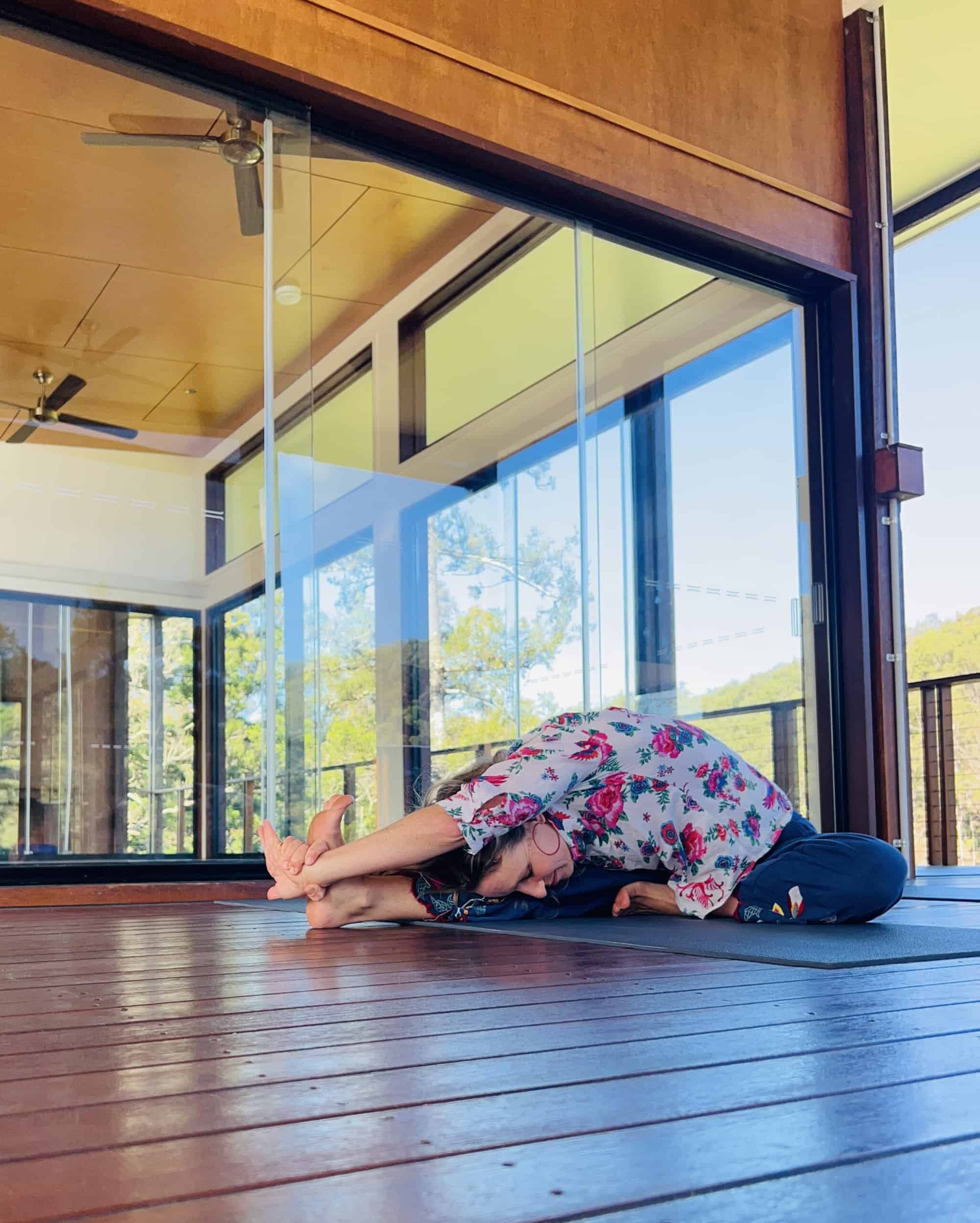Derived from the word janu = knee, sirsa = head and asana = pose. Thus, Janu Sirsasana directly translates to “Knee-Head Pose”.
How to perform Janu Sirsasana
1. Begin by sitting on a folded blanket on the floor with your legs stretched out in front of you. As you inhale, bend your left knee and pull it to the left, placing the outer parts of your left calf and thigh on the ground. Put your left heel against the inner part of the left thigh, nearing the perineum region. The big toe of your left heel should be in contact with the inner side of the right thigh. Ensure to make an obtuse angle between the two legs. Take care to not keep the left knee in line with the left thigh, which is placed perpendicular to the extended right leg. Try to take the left knee as far away from the body as possible so that the body is extended from the bent leg.
2. Stretch and extend both arms forward towards the right foot and clasp it with both hands. Begin with catching the toes of the right foot, gradually catching the right sole and right heel, and ultimately extending the arms; hold the wrist of one hand with the other beyond the right foot. The right leg should be extended all the way, and the knee should be tense. Make sure the back of your right knee is touching the ground.
3. During an exhalation, move the upper torso forwards by bending the elbows and widening them. Initially, place the forehead down, then the nose, followed by the lips and the chin beyond the right knee on the right shin. Then place your face on either side of the right knee joint.

At first, the right leg may lean slightly to the right. Make sure that the right leg does not bend. With your back fully extended, pull your upper body forward and press your chest against your right thigh. Hold in this pose for about 30-60 seconds. Carry on a soft and long breath. You can also perform this pose after holding your breath after each exhalation.
4. During an inhalation, raise your upper torso and head, stretch and straighten your arms and focus your gaze upwards for a few seconds while extending the spine and making it concave. Release the right foot, extend the left leg, and return to the beginning position. Repeat the pose with the left leg extended outwards, and the right leg bent at the knee. Hold in the pose for a similar duration of time on both sides.

Janu Sirsasana Benefits
Western Physiology
Janu Sirsasana has a therapeutic effect on mental and physical health.
- Janu Sirsasana improves mental health:
- It helps calm the mind and relieve symptoms of mild depression (Alexander et al., 2013; Guner & Inanici, 2015).
- It may be a therapeutic pose for insomnia (Alexander et al., 2013; Guner & Inanici, 2015).
- Janu Sirsasana is good for your spine:
- This pose helps alleviate low back and radicular leg pain, such as that caused by lumbar disc herniation (Plastaras et al., 2015).
- This pose helps strengthen and lengthen the spine (Amin & Goodman, 2014) while developing elasticity and balances tension within the lower back (van Puymbroeck et al., 2007).
- Janu Sirsasana stretches and strengthens the muscles:
- It helps stretch the hip flexors and hamstrings (Amin & Goodman, 2014), shoulders (Guner & Inanici, 2015), and groin.
- Other therapeutic effects of Janu Sirsasana include but are not limited to:
- This pose helps tone the spleen and liver, thereby improving digestion. It also helps in toning and activating the kidneys.
- The pose is recommended for individuals who have been suffering from a low-grade fever for a long time.
- Help alleviate fatigue (Guner & Inanici, 2015; Singh, 2020).
- It helps in relieving menopause.
- This pose, in tandem with others, helps relieve headaches and menstrual discomfort (Guner & Inanici, 2015; Yonglitthipagon et al., 2017).
- It is therapeutic for sinusitis and high blood pressure.
- This pose, in tandem with others, can be a feasible adjunct therapy for inflammatory bowel disease (Arruda et al., 2018).
- It also helps and benefits individuals who suffer from prostatic enlargement.
Yogic Physiology
According to Ayurveda, this posture has a calming and cooling effect on the body and mind and is therefore very good for reducing heat or pitta. It is particularly effective for vata (calming) and pitta (cooling) types. Similar to most forward bends, it soothes vata imbalances. This posture is excellent for the flow of apana vayu – the downward flowing prana from the lower back to the feet. It removes waste products from the pranic field and therefore, the body and mind. This downward flowing prana governs reproductive health, lower colon health, health of the bladder and urethra. It also has the effect of calming the mind and reducing mental waste. The outbreath or focus on exhalation will accentuate the downward flow.
The yogic practice of mulabhanda, which involves tightening muscles of the perineum, is good for the marma point Guda (anus). The heel of the foot placed to the perineum will also stimulate this marma point, which controls the first chakra, apana vayu, the channels involved in excretion: urinary, reproductive and menstruation.
It has a calming effect on the mind as the point between the eyebrows and the head (sthapani marma) comes to the knee (janu marma).
You may also wish to include the seed mantra LAM for this chakra. Meditation on this chakra can assist with controlling the earth element, sense of smell and excretory system.
Contradictions and Cautions
- Individuals suffering from asthma and diarrhea should avoid this pose.
- If you are suffering from a knee injury that doesn’t allow for full flexion, support it on a folded blanket or a bolster.
- To strengthen the knee joint of the folded leg, place an eye pillow or your hand behind the knee and squeeze the back of your knee to the object of choice.
Preparatory Asanas
- Adho Mukha Svanasana
- Baddha Konasana
- Balasana
- Supta Padangusthasana
- Uttanasana
- Vrksasana
Follow up Asanas
- Seated forward bends
Tips for Beginners
Ensure that the bent leg’s foot does not slip under the straight leg. You should be able to look down and see the sole of your foot. Keep the bent leg active as well. Broaden the top of the foot on the floor and press the heel toward the inner groin of the straight leg.
Variations
In some yoga schools, this pose is also performed with the perineum sitting on the bent-knee heel. The leg bent at the knee is laid aside at an angle of slightly less than 90 degrees.
Modifications and Props
Use a yoga strap if you cannot reach the foot of your outstretched leg. Wrap the strap around your foot’s sole and hold it with your arms fully extended. Do not pull yourself forward when using the strap; lightly run your hands over the strap, keeping your arms and front of your body extended.
Deepen the Asana
The pose can be made more challenging by increasing the angle between the two legs by more than 90 degrees. Instead of pressing the heel of the bent knee against the perineum, press it firmly against the groin on the same side. Do this only if you have sufficient flexibility in the legs, hips, and back.
References
Alexander, G. K., Innes, K. E., Selfe, T. K., & Brown, C. J. (2013). “ More than I expected”: Perceived benefits of yoga practice among older adults at risk for cardiovascular disease. Complementary Therapies in Medicine, 21(1), 14–28. https://doi.org/10.1016/j.ctim.2012.11.001
Guner, S., & Inanici, F. (2015). Yoga therapy and ambulatory multiple sclerosisAssessment of gait analysis parameters, fatigue and balance. Journal of Bodywork and Movement Therapies, 19(1), 72–81. https://doi.org/10.1016/j.jbmt.2014.04.004
Plastaras, C. T., Huang, L. Y., & Metzger, C. J. (2015). Yoga Therapy for Management of Neck and Low Back Pain. Journal of Yoga & Physical Therapy, 05(04). https://doi.org/10.4172/2157-7595.1000215
Amin, D. J., & Goodman, M. (2014). The effects of selected asanas in Iyengar yoga on flexibility: Pilot study. Journal of Bodywork and Movement Therapies, 18(3), 399–404. https://doi.org/10.1016/j.jbmt.2013.11.008
van Puymbroeck, M., Payne, L. L., & Hsieh, P. C. (2007). A phase I feasibility study of yoga on the physical health and coping of informal caregivers. Evidence-Based Complementary and Alternative Medicine, 4(4), 519–529. https://doi.org/10.1093/ecam/nem075
Singh, C. (2020). Benefit of Yoga Poses for Women during Pregnancy. April, 18–22.
Yonglitthipagon, P., Muansiangsai, S., Wongkhumngern, W., Donpunha, W., Chanavirut, R., Siritaratiwat, W., Mato, L., Eungpinichpong, W., & Janyacharoen, T. (2017). Effect of yoga on the menstrual pain, physical fitness, and quality of life of young women with primary dysmenorrhea. Journal of Bodywork and Movement Therapies, 21(4), 840–846. https://doi.org/10.1016/j.jbmt.2017.01.014
Arruda, J. M., Bogetz, A. L., Vellanki, S., Wren, A., & Yeh, A. M. (2018). Yoga as adjunct therapy for adolescents with inflammatory bowel disease: A pilot clinical trial. Complementary Therapies in Medicine, 41(September), 99–104. https://doi.org/10.1016/j.ctim.2018.09.007
If you would like to contact Celia to learn more about the meditation teacher training journey, please do visit our Meditation Teacher Training Page or find us on Facebook or Instagram or contact Celia directly.


